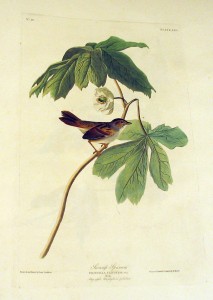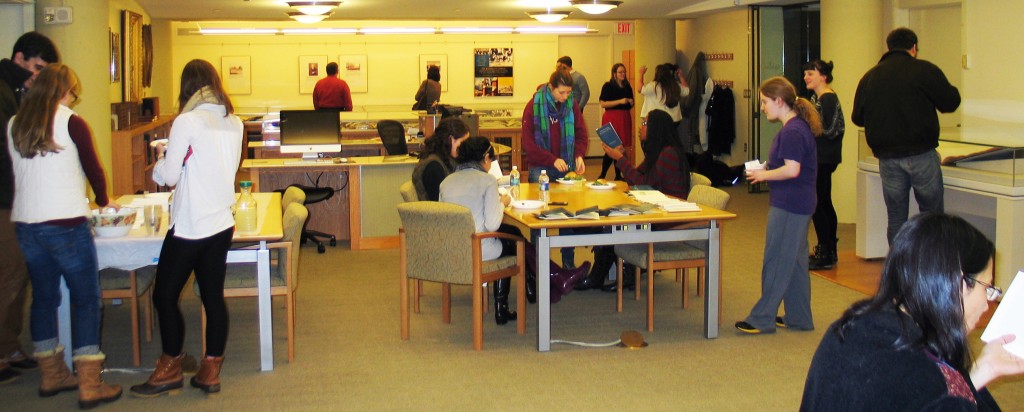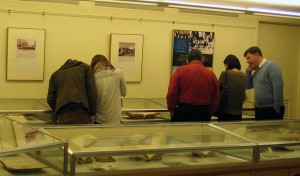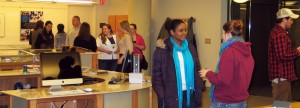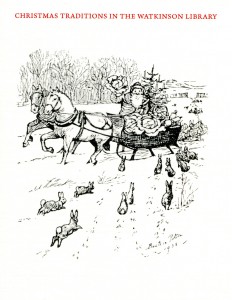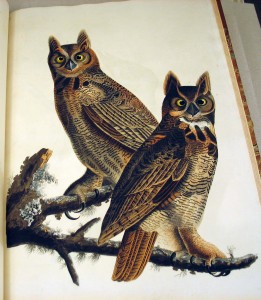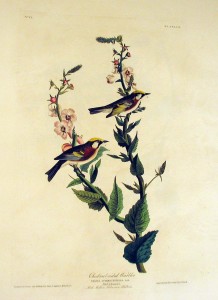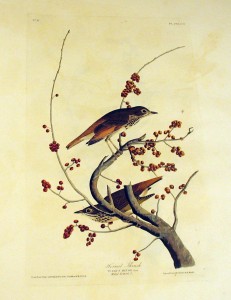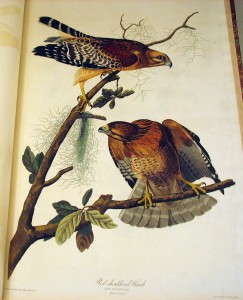[NB: This bird, numbering in the billions in Audubon’s time, is now extinct. The last one died on Septemer 1, 1914, at the Cincinnati Zoo.]
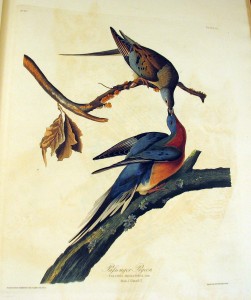 “The Passenger Pigeon, or, as it is usually named in America, the Wild Pigeon, moves with extreme rapidity, propelling itself by quickly repeated flaps of the wings, which it brings more or less near to the body, according to the degree of velocity which is required . . .
“The Passenger Pigeon, or, as it is usually named in America, the Wild Pigeon, moves with extreme rapidity, propelling itself by quickly repeated flaps of the wings, which it brings more or less near to the body, according to the degree of velocity which is required . . .
The multitudes of Wild Pigeons in our woods are astonishing . . . In the autumn of 1813, I left my house at Henderson, on the banks of the Ohio, on my way to Louisville. In passing over the Barrens a few miles beyond Hardensburgh, I observed the Pigeons flying from north-east to south-west, in greater numbers than I thought I had ever seen them before, and feeling an inclination to count the flocks that might pass within the reach of my eye in one hour, I dismounted, seated myself on an eminence, and began to mark with my pencil, making a dot for every flock that passed. In a short time finding the task which I had undertaken impracticable, as the birds poured in in countless multitudes, I rose, and counting the dots then put down, found that 163 had been made in twenty-one minutes. I travelled on, and still met more the farther I proceeded. The air was literally filled with Pigeons; the light of noon-day was obscured as by an eclipse, the dung fell in spots, not unlike melting flakes of snow; and the continued buzz of wings had a tendency to lull my senses to repose.
Whilst waiting for dinner at YOUNG’S inn at the confluence of Salt river with the Ohio, I saw, at my leisure, immense legions still going by, with a front reaching far beyond the Ohio on the west, and the beech-wood forests directly on the east of me. Not a single bird alighted; for not a nut or acorn was that year to be seen in the neighbourhood. They consequently flew so high, that different trials to reach them with a capital rifle proved ineffectual; nor did the reports disturb them in the least. I cannot describe to you the extreme beauty of their aerial evolutions, when a Hawk chanced to press upon the rear of a flock. At once, like a torrent, and with a noise like thunder, they rushed into a compact mass, pressing upon each other towards the centre. In these almost solid masses, they darted forward in undulating and angular lines, descended and swept close over the earth with inconceivable velocity, mounted perpendicularly so as to resemble a vast column, and, when high, were seen wheeling and twisting within their continued lines, which then resembled the coils of a gigantic serpent.
Before sunset I reached Louisville, distant from Hardensburgh fifty-five miles. The Pigeons were still passing in undiminished numbers, and continued to do so for three days in succession. The people were all in arms. The banks of the Ohio were crowded with men and boys, incessantly shooting at the pilgrims, which there flew lower as they passed the river. Multitudes were thus destroyed. For a week or more, the population fed on no other flesh than that of Pigeons, and talked of nothing but Pigeons.”
–J. J. Audubon, Ornithological Biography, I (1831), 319-321 [excerpted].
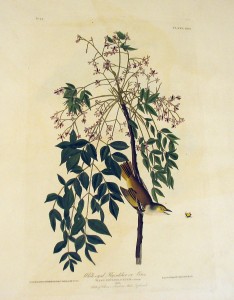 “These birds become at once so abundant, that it would be more difficult not to meet one, than to observe a dozen or more, during a morning walk. Their motions are as animated as their music. They pass from twig to twig, upwards or downwards, examining every opening bud and leaf, and securing an insect or a larva at every leap. Their flight is short, light, and easy. Their migrations are performed during the day, and by passing from one low bush to another, for these birds seldom ascend to the tops of even moderately tall trees. Like all our other visitors, they move eastward as the season opens, and do not reach the Middle States before the end of April, or the beginning of May. Notwithstanding this apparently slow progress, they reach and disperse over a vast expanse of country. I have met with some in every part of the United States which I have visited.
“These birds become at once so abundant, that it would be more difficult not to meet one, than to observe a dozen or more, during a morning walk. Their motions are as animated as their music. They pass from twig to twig, upwards or downwards, examining every opening bud and leaf, and securing an insect or a larva at every leap. Their flight is short, light, and easy. Their migrations are performed during the day, and by passing from one low bush to another, for these birds seldom ascend to the tops of even moderately tall trees. Like all our other visitors, they move eastward as the season opens, and do not reach the Middle States before the end of April, or the beginning of May. Notwithstanding this apparently slow progress, they reach and disperse over a vast expanse of country. I have met with some in every part of the United States which I have visited.